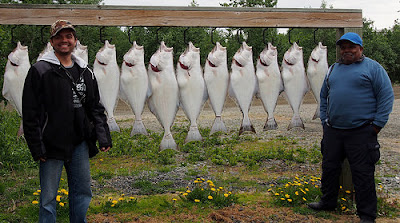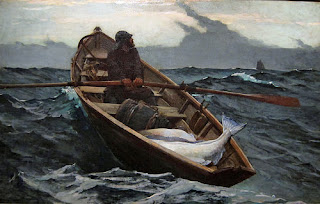from
Behind the French Menu
by
Bryan G. Newman
behindthefrenchmenu@gmail.com
A large catch.
In France Halibut is usually the Atlantic halibut, but if the menu notes flétan noir, then that is the smaller Greenland halibut, an equally tasty fish. There is a Pacific halibut but France’s has easier and closer access to the North Atlantic. Halibut has a delicate taste, with a firm and bright, sweet, white flesh that will most likely be on the menu poached or baked, and served with a sauce. Halibut cheeks are sweet and considered a delicacy.
The fog warning (1885).
Painting: Winslow Homer (1836-1910)
Fishing in the Grand Banks off Newfoundland. Museum of Fine Arts, Boston.
Halibut on French Menus:
Filet de Flétan Sauce Saint-Péray Garni – Filet of halibut with vegetables served with a sauce made with the Saint Peray AOP sparkling wine. The Saint Peray AOP is an enjoyable white, sparkling, wine from the Northern Rhone. It is similar to other sparkling wines, for example, a Cremant; it is made with the Méthode Champenoise but with different grapes to Champagne.
Ballotine de Truite et Flétan Fumé – An entrée, the French starter, of cold stuffed and fileted trout served together with smoked halibut.
Filet de Flétan à la Crème d'Oseille – Filet of halibut served with a cream of sorrel sauce.
A mouth watering dish of halibut and asparagus.
Filet de Flétan Noir Vapeur, Risotto Safrané et Beurre Blanc à l’Aneth - Steamed Greenland halibut served with a risotto flavored with saffron and Beurre Blanc Sauce flavored with aniseed.
Flétan au Ragoût de Palourdes, Asperges Confites et Tomates Cerises – A stew of halibut and clams, flavored with an asparagus compote and cherry tomatoes.
Halibut with mango, asparagus and tomato
Photographer’s note: “Delicious”
Photograph courtesy of stu_spivack
Le Filet de Flétan Poché, Sauce aux Citrons de Sicile – Poached filet of halibut served with a sauce made from Sicilian lemons.
Le Filet de Flétan Sauce Bretonne - A filet of halibut served with a Sauce Bretonne. For fish Bretonne Sauce is a white sauce made with fish stock, butter, mushrooms and white Muscadet wine.
Mille-Feuilles de Saumon Fumé et Flétan – Mille-Feuilles, interwoven leaves, of smoked salmon and smoked halibut.
Halibut cheeks.
Halibut are the largest of all flounders and among the largest of all fish. Fishermen and women occasionally land fish that weigh over 300 kilos; however, if you go out fishing do not expect a halibut weighing much over 10 kilos (22 lbs).
Here they really have caught a large halibut.
Photograph courtesy of Andrea Pokrzywinski
Halibut in the languages of France's neighbors:
(Catalan - Halibut de l'Atlàntic), (Dutch - heilbot), (German - heilbutt), (Italian - passera artica or halibut), (Spanish -– fletan).
Connected Posts:
Behind the French Menu
by
Bryan G. Newman
behindthefrenchmenu@gmail.com
Copyright 2010, 2016.
















